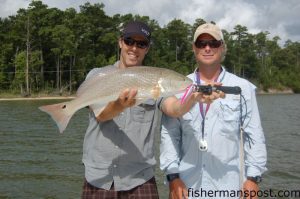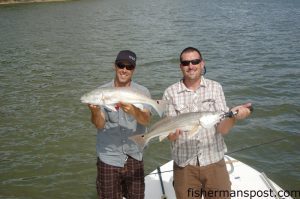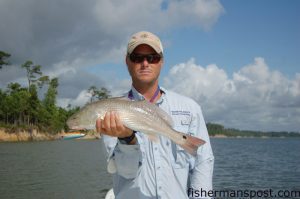Tournament Trail Triplets

Gary Hurley, of Fisherman's Post, and Capt. Rennie Clark, of Tournament Trail Charters with a tournament-perfect 27" red drum that crushed a topwater plug in a bay behind Topsail Island.
When I talked to Capt. Rennie Clark, Jr., of Tournament Trail Charters, after his win at the second Redfish Action Series Tournament a few weeks ago, he described a scene many anglers can’t even imagine—a huge school of hundreds of happy, hungry red drum milling around the boat, enabling Clark and his tournament partner Hurricane Drew Ardnt to select individual fish they wanted, cast to them, and hook up. When he asked if Gary Hurley and I wanted to go on the Guide Time Trip we’ve been tossing around for more than a year, to say I was excited would be a severe understatement.
Rennie gunned the 250 Yamaha powering his 22’ Shearwater bay boat after meeting up with us at the Pecan Grove Ramp behind south Topsail, pointing the boat north up the ICW. The man targets red drum almost exclusively, and he finds the fish from the Southport area all the way up to Morehead City. On our way north, he managed to let it slip that we’d be hitting up his number one tournament spot, and my anticipation to get on the fish came to a peak.
Fortunately, we made quick work of our run at 50 mph, and Rennie was soon guiding the Shearwater through a twisting channel into a bay behind Topsail.
As he flipped his trolling motor over the bow, it was easy to see why the area might be attractive to redfish. The few hundred yards of water between the boat and the marshy bank was literally covered in finger mullet, only broken up by tight balls of peanut pogies that kept the mullet from having a baitfish monopoly on the cove.
Rennie handed us each a rod rigged with a Rapala Skitterwalk, his favorite topwater, and told us to have at it. Mine was a smaller plug in a frog pattern, and Gary had a larger model featuring a bright electric blue, chrome, and orange scheme.
Rennie chose a chartreuse hued weapon, and the three of us began casting while Rennie expounded on his redfish search philosophy.
“If you know what habitat to look for, you can find these fish anywhere in the country they live,” he said, guiding the boat parallel to the shoreline with the trolling motor remote dangling from his neck. “It works here, in Charleston, Savannah, southwest Florida, and the northern Gulf. Cast towards those dark grass patches over there.”
“Don’t jerk when they blow up on it, right?” Gary questioned the captain. “Just wait for the pull?”
Rennie affirmed that Gary had the right strategy, as it’s easy to pull the bait with a sharp jerk away from a hungry red that’s missed the lure. If an angler continues to work the plug, the fish will almost always keep trying to eat it.
Gary and I continued casting, working the walking surface baits back to the boat in a rhythmic line dance. We’d gone all of 100’ from where we started fishing when the still water’s surface was broken by a hungry redfish. The drum tried to eat Gary’s garish offering twice before finally pulling the plug under the water to an unpleasant introduction to its pair of treble hooks.
“I didn’t jerk!” the publisher shouted triumphantly as his rod bent under the struggle of an unhappy red and the reel begrudgingly surrendered some drag. “Got him!”
A few moments later, the fish was visible a few feet toward the bank off the bay boat’s port gunwale. Rennie was ready with a net, but when he saw the fish, he set it down.
“It’s a pup,” the captain said, eyes on the fish. “Just swing him right over here.”
The fish was around 20” long, a respectable slot red and enough to bring a smile to Gary’s face for a quick photograph, but not the kind of fish that earns a check in a highly competitive redfish tournament.
After a quick photograph, Rennie slid the red back in the water and instructed us on how to revive the fish before letting them swim off.
“Just hold them by the tail and swish them back and forth in the water,” he explained, gently moving the fish through the water until a strong tail flip sent it back on its way to harassing the local mullet population. “When they kick out of your hands, they’re good to go.”
With the skunk off the boat a mere five minutes after Rennie dropped the trolling motor into the water, we were all excited, and I anxiously awaited my first hookup while Rennie explained a little more about his tournament search strategies.
“Almost every day, I’ll go back out scouting after I drop my charter off,” he said as we returned to casting. “A lot of the time I don’t even fish; I’ll just run with the big motor until I push some fish into showing themselves.”
Rennie had plenty more to say, but he stopped short as a school of finger mullet showered out of the water a hundred yards off the bow.
“Whenever you see that,” he explained, pulling us toward the action with the trolling motor, “that’s where you need to cast.”
As we closed in, I got a blow up on my plug and felt the rod bow over as a stubborn red turned away from the faux finger mullet that was now hooked in its jaw.
Like Gary’s, this red was stubborn at the outset but soon relented to the heavy pressure I was putting on it, turning towards me after pulling off a few yards of line.

Gary Hurley and Max Gaspeny with the results of one of many doubleheaders of upper slot red drum they hooked on topwater plugs while fishing behind Topsail with Capt. Rennie Clark of Tournament Trail Charters.
“We don’t fish TV drags in the tournaments,” Rennie explained. “I don’t let them run any more than I’ve got to.”
My fish was a touch smaller than Gary’s, and I soon swung it into the cockpit after some modest drama as it tried to swim under the outboard raised off the stern.
When it hit the deck, my plug was barely visible in its mouth.
“They really eat that little plug,” Rennie said, opening the red’s mouth to reveal nothing but Skitterwalk.
Almost as soon as Rennie pulled the hooks out of the fish and revived it, Gary was on again, this time with a fish that had a little more power to it.
I was soon back to casting, hoping I could match up with the second half of a double header before the boss had his fish to the boat.
Though Gary’s red put up a valiant struggle against the pressure he was applying for the better part of five minutes, I was unable to find it’s counterpart before the fish was nearing the boat.
This fish had Rennie a little more excited.
“That’s the one you want in a tournament,” our guide explained, this time plainly set on using the net.
“Keep his head up when you get him to the boat,” he continued as Gary endeavored to counter the red’s final bursts of resistance.
Rennie soon slid the landing net under the fish and was holding it up to the ruler stuck to the side of the boat.
“It’s 26.5 inches,” he said, obviously pleased to have found the class of fish that he looks for in competition. “Let’s see how much he weighs.”
The red pulled Rennie’s Boga Grip scale down to just over the 7 lb. mark.
“He’s over 7,” the captain revealed, holding the fish up in the sun. “Two of these will win a tournament.”
After a quick series of photos, the red was returned to the water, and Gary revived his fish while I went back to casting.
Three or four twitches into my next cast, a red blew up under my plug but completely missed the bait. I continued working the bait, and it only danced back and forth for another moment before the fish was back, plainly angry at missing its meal on the first attempt.
This time it found the hooks, and I was treated to what was clearly a larger fish on the order of Gary’s. The drag held the red’s run to a dozen yards or so, and I worked the fish towards the boat only to discover that Gary had taken the task of hooking up a double header seriously and was working on a fish of his own.
Mine was at the boat first, and I tried to comply with Rennie’s suggestion to keep its head up while leading it to the net. The stubborn fish foiled my first attempts, but Rennie was finally lifting the fish over the side after it took me on a lap around the boat just beyond the captain’s reach.
Gary’s fish was soon to the boat as well, and we celebrated our first doubleheader with a photo session and a Gatorade, well-earned we felt. Both of these fish were also tournament perfect, nearly 27” long and weighing between 7-8 lbs.

Capt. Rennie Clark, of Tournament Trail Charters, with a slot redfish that fell for a topwater plug in a bay behind Topsail Island.
“When you find areas like this,” he explained as we slid down the bank towards another school of showering finger mullet, “the fish will be here day after day on the same tide. Year after year, too. It’ll be different fish year to year, but usually about the same size.”
Our next casts produced our first triple hookup, and after battling the reds to the boat, we tried resting Rennie’s camera on the poling platform and using the self-timer to get a picture of the redfish trio.
After we revived and released the reds, Rennie looked back through the photos and realized that we hadn’t gotten a great shot.
“We’ll have to try a little harder on our next triple,” he said as we went back to casting. Not many anglers can guarantee success on a single topwater red hookup, but after the fast and furious fishing hour we’d had, I shared the captain’s confidence that we’d end up with another triple.
Obviously, the steady walking retrieves we were employing were working out well, but Gary had a question. “Is a steady retrieve always the best,” he queried, eyeing another school of panicked mullet.
“I almost always start with a quick, steady retrieve,” Rennie replied, in a rare moment when none of us were hooked up, “but sometimes they like it a little different. They’ll actually eat the plug sitting still in the water a lot of times.”
This point was belabored without question moments later as Rennie was assisting us with landing and unhooking another double header of reds, Gary’s another tournament perfect fish and mine a bit smaller.
I heard a splash off the port bow and looked up just in time to see the rod Rennie had left on the bow yanked into the water as a red annihilated the topwater floating motionless a dozen yards towards the bank. Fortunately, it didn’t stay hooked long, and we were able to pluck the rod from where it landed in the water after releasing our fish.
The action slowed down for a moment, and Rennie rounded a corner of the bank, taking us to where he’d found the largest school of reds in the tournament just ten days before. I was prepared to be amazed if the topwater action could get any better, as this was by far the best topwater bite I’d ever seen, but after the series of events over the last couple of hours, I was also in no position to doubt the captain.
It took a few minutes of casting without a bite before Gary had a few blowups that didn’t lead to fish, and I spotted something different off the bow.
“Is that just a clay bottom area or something?” I asked, gesturing to an area colored like the red clay dirt I grew up with in central NC.
“No, that’s fish, and a lot of them,” Rennie replied. “They make muds like that when they’re feeding.”
He’d fired his topwater towards the school before I registered what had been said, and Gary and I both followed suit.
Rennie was hooked up to a fish before I’d even started working the lure, and even the non-TV drag couldn’t turn this fish quickly.
“That’s a good fish,” the captain said, “probably over 30 inches.”
His fish was still running when a red found my topwater irresistible, and I was also soon holding on as a red ran. Gary’s plug lasted only a few more seconds before it, too, was crushed, and indeed we were fast to the day’s second triple header.
Gary and I had both hung pups in the low-20” range, and as our fish neared the boat, Rennie still had plenty of line out and his prediction about the fish’s size seemed accurate.
Hoping for that second tripleheader photo op, we left our reds in the water while Rennie worked away at his bruiser.
Eventually, the battle turned in his favor, and the red grew nearer and nearer to the boat. Gary and I swung our fish aboard just before Rennie got his to the net, and we soon had the redfish trio on deck.
Taking a photo with a self-timer on a rocking boat isn’t exactly easy, especially when three guys with three reds are trying to crowd in without blocking each other’s fish or faces, and this one didn’t come out quite stellar, either. Having no one on the boat to take a picture because everyone is occupied with a fish is one of those good kinds of problems, though, and we were elated as we returned the reds to the water.
A few more minutes casting produced a few more hookups, and I honestly have no idea how many we caught over the few hours we fished. I lost count somewhere around 30, and no one on board even made a cast with a subsurface lure. I did have to tie on two new topwaters though, as the combination of the reds’ strong jaws and the heavy drags took quite a toll on the plugs. One of mine fell victim to hopelessly mangled hooks after many a red, and another lost it’s back hook, split ring, and hanger entirely.
“Nobody makes a plug that will stand up to too many of these things,” Rennie said as I marveled at the devastated lures.
As we headed back towards Pecan Grove, I realized that I’d caught more reds on topwater in the last few hours than in the rest of my life combined, a pleasant revelation for sure.
Redfish are Rennie’s specialty and passion in the fishing world, and when he’s not busy placing high in local tournaments, he’s putting people like Gary and I on the fish. A red trip with the man is sure not to be a disappointment, and anglers can talk to him about a charter by calling (910) 262-5402 or log on to www.tournamenttrailcharters.com for more information.
